Hata Clan is thought to have immigrated to the northern part of Kyusyu,led by the lord of Yumizuki and spread over the country.
Because historical data related with Hata Clan exists over the country,it is known that the scale of the clan is very large.
Especially, the data on Hata Clan concentrates in Usa Province in the northern part of Kyusyu Island and Sanin district.
They were originally a nomadic people and moved over the wide range, bringing many technologies to all through country.
Among those technologies there is copper manufacturing from Sila,which related with the copper mines in the northern part of Kyusyu Island and Kinki district.
Hata Clan are also considered to be connected with the technologies of silkworm raising and manufacturing of silk fabrics, according to transmissions in old history books.
Moreover, some of them were engaged in the writing and accounting in the Imperial Court and had a strong connection with officers in it.
They scattered over the provinces and worked under the powerful clans,but Hata Sakenokimi gathered them under the control of him.
Hata Sakenokimi led the member of the clan,and they were engaged in the silk-warm raising and offered the products to the Imperial Court as a tribute.
The tribute is said to have piled high.
So,the finance ministry was set up in the Court,and Hata Sakenokimi was in charge of accounts as a minister of it.
Hata Clan had become active since the time of Hata Kawakatu under the era of Emperess Suiko.
Around the 8th century when Hata Kawakatu built the Kouryuuji Temple,the unification of Japan had completed.
After that,Hata Clan was committed to the construction of the capitals such as Nagaokakyo and Heiankyo with its high technology of the construction and the engineering.
The technologies Hata Clan brought from the Korean peninsula covered the wide varieties such as construction and engineering,silk-warm raising, weaving, and brewing.
And the level of thier technologies were all remarkably high.
Especialy,no other clans could compete with Hata Clan in the technology of the engineering and the building the dam at the Katuragawa River in order to control the amount of water.
Words of Karl Jaspers,German Philosopher.
I have many opportunities to see many sculptures showing the most completed figures of human beings. Also have I seen the sculptures of ancient Greek and many excellent ones carved in Roman era.
However, they held a hint of smell of secular things that they hadn't yet be able to transcend.Impurity and vulgar atmosphere remained in even Greek sculptures that should most express the fruit of intelligence and beauty.
Religious sculptures of Roman era expressing the love of Christianity couldn't embodied the purified joy completely.
However,the sculpture of Miroku Buddhism embodied the full ideal of human being.It is the most purified, peaceful and eternal symbol of human being transcending the times and restrictions in the secular world.I haven't seen in my life such an artistic embodiment of peaceful human existance.
|
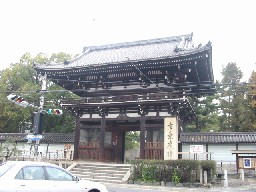
|
Kouryuji Temple
Hata Kawakatu who had lived at the time of Prince Shotoku and Emperess Suiko was the founder and the major person of the transmission of Hata Clan.
He willingly took on deifying Buddhism scripture when Prince Shotoku received it from the envoy of Sila in 606.
The temple set up for the sake of deifying the scripture was Mineoka Temple later called Kouryuuji Temple.
|
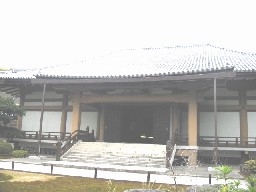
|
Main Hall of Kouryuji Temple
There are many Buddhism scriptures designated as a national treasure such as Amida Kannon Nyorai and Miroku Bosatu in the main hall of Kouryuji Temple at Uzumasa in Kyoto.
Some Scholars insist that Kouryuji Temple was originally a temple of "Keikyo"(Chinese Chrisitinity)
|
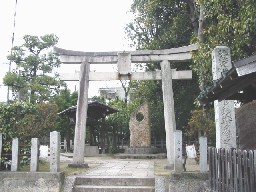
|
Oosake Shrine
There is Oosake("大酒") Shrine founded by Hata Clan near Kouryuuji Temple.
The memoir says that the name of shrine was originally Oosake("大辟")Shrine,and
"大辟"means "David"in Keikyo.
Was this shrine built by the ancestor of Hata Clan for the memorial of the King of ancient Israel?
|
|
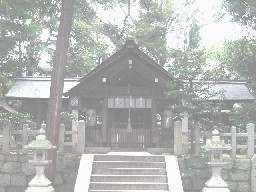
|
Kijima Shrine
About Kaikonoyashiro or Kijimajinjya Shrine located at Uzumasa,memoior says that "Keikyo"(Chinese Christianity)was transmitted here, and this shrine is said to have been related with Hata Clan.
|
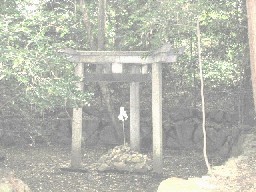
|
Triangle Torii
At Kijima Shrine, a triangle ""Torii" which hardly can be seen all through the country.Although called Torii,it is not a gateway to shrine,but it stands at the center of a pond.
Some scholars says that it symbolizes the god of "The Trinity" Hata Clan wordshiped.
|
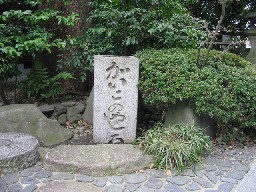
|
Kaikono Yshiro Shrine
Kijimajinjya Shrine was founded by Hata Clan and other name of it is Kaikonoyashiro.Kaiko means a silkworm.Hata Clan originally was engaged in silkworm-raising and silk-weaving.
The trade of silk on the Silk road was enjoyed by Jew or Christians exclusively and silk-weaving was called "Hataori" after Hata Clan in Japanese.
|
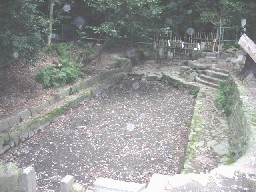
|
Mototadasu Pond
The pond adjoined by triangle Torii is in the precincts of Kijima Shrine.It is said that Keikyo Christians had been baptized as the manifestation of the belief to "Trinity".
The pond is called "Mototadasu" which means repentance and returning to righteousness.
|
|
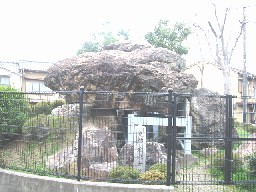
|
Hebizuka Mound
There is a mound of some 20 huge stones near Kouryuji Temple.This is a key-holder-style grave in which the lord of Hata Clan was buried.
At the time of building the grave,the earth was covered on it,but it was washed away by wind and rain,and as a result only the stone room is exposed.
Long time ago, snakes had lived gregariously in the stone room, which is the origin of the name of the mound "Hebizuka".("Hebi"means snake)
|
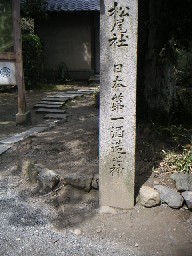
|
Matuo Shrine
Matuo Shrine is the guardian deity of Hata Clan.It is noticeable that the deity was referred in the history book "Kojiki".
Matuo Shrine was related also with Gagaku,Japanese Court Music and Dance.
According to the documental data in the middle age,It connected with Shitennouji Temple.
There are Brewing Material Hall,and many tools for brewing since Edo period are displayed there.
There is a stone monument of the deity of brewing in the precepts of Matuo Shrine,showing the relation between Hata Clan and brewing.
|
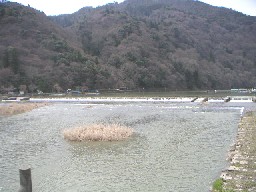
|
Kadono Great Dam
The upper streams of Kadono River is called "Hozugawa River"and "Katuragawa River".Hata Clan constructed a great dam and reclaimed Sagano Field.
On the case of constructing new capital "Heiankyo", timbers cut in the Tanba province were brought via Hozugawa River or Oozeki River to the new capital Heiankyo.
In the Edo period,Suminokura Ryoui launched an excavation work of Oozeki River in March,1606 and completed it in August,1606.
|
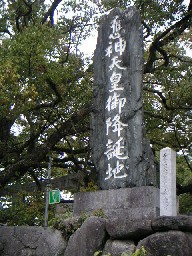
|
Umihachiman Shrine
Umihachimangu Shrine is the birthplace of Emperor Oujin,the child of Empress Saimei,and is located at Umi Town in Kasuya County in Fukuoka Prefecture.
It was Emperor Oujin who welcomed Hata Clan from China.
"Yumizuki",the homeland of Hata Clan,is near the Tien Shan and the name of "Tien Shan"is found in some places of Kyusyu Island.
|
E-mail to
Yoshimura Naohiro.
|











